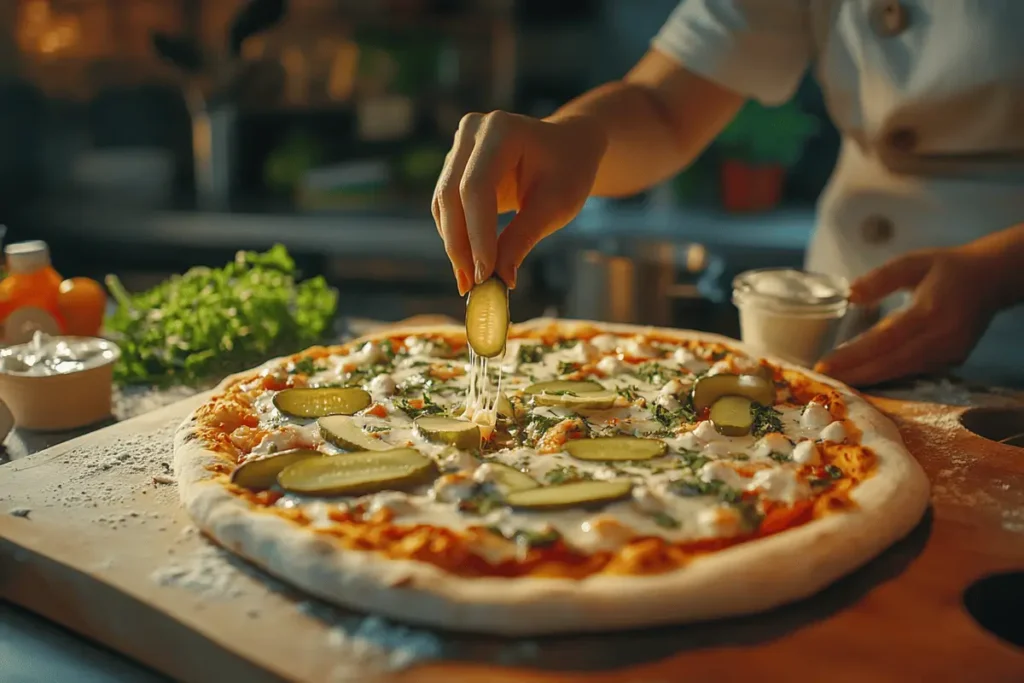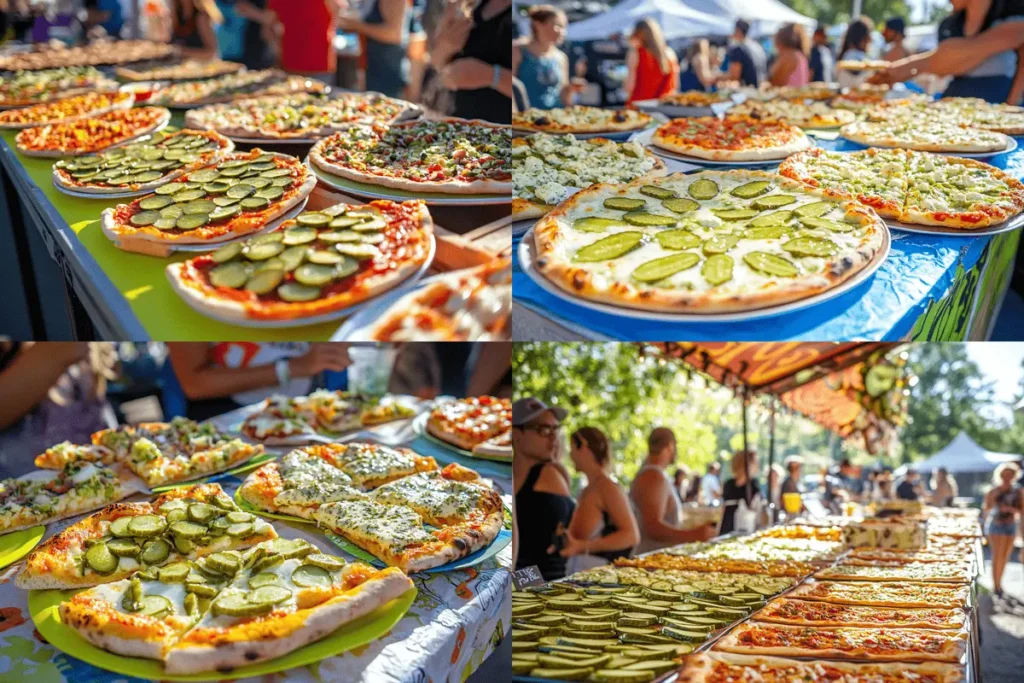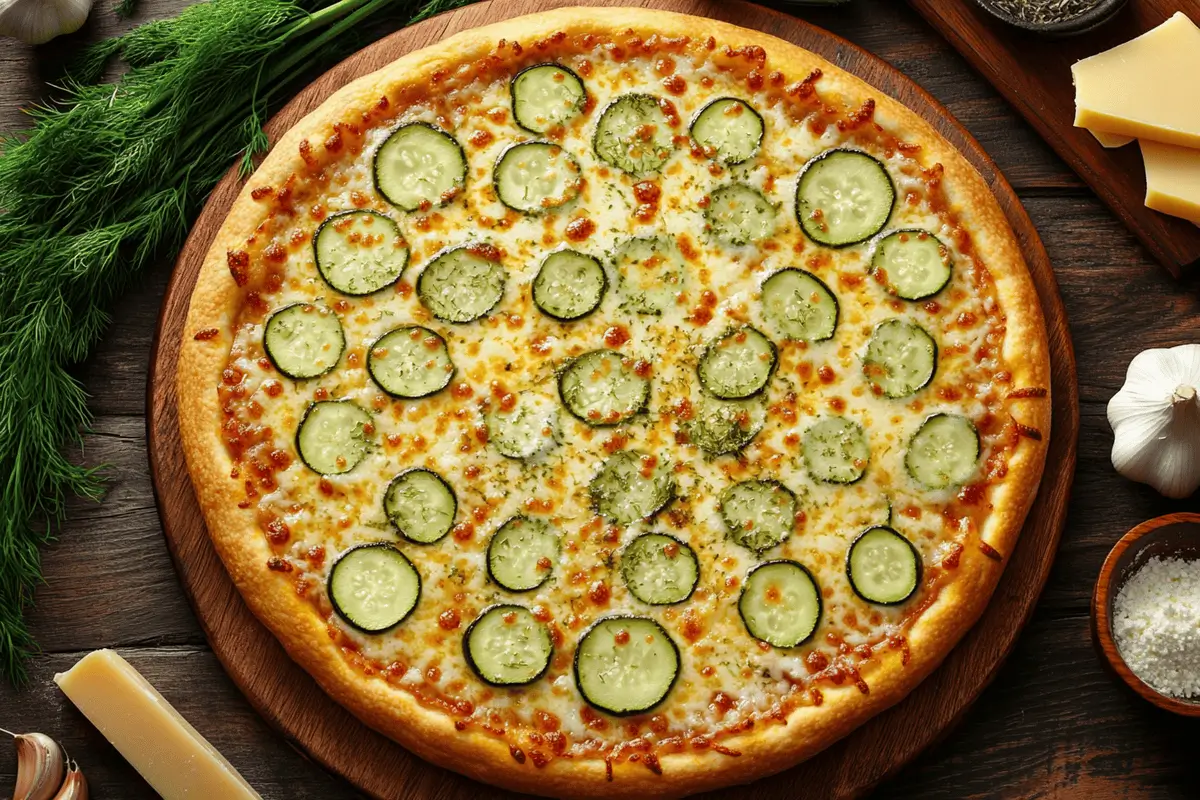Introduction
Pickle pizza—wait, what? This unlikely combination of tangy pickles, gooey cheese, and crispy crust might sound bizarre, but it’s taken the food world by storm. What started as a quirky experiment has now found a permanent spot on menus, from local pizzerias to nationwide chains. But where did pickle pizza come from? How did this offbeat creation gain such a loyal following?
In this article, we’ll dive into the roots of pickling, uncover the origin stories and explore why this dish became a viral sensation. Along the way, we’ll also discover the science behind its bold flavor and how regions have embraced their own pickle pizza twists. By the end, you’ll know exactly why this tangy treat is here to stay.
The History of Pickles in Cuisine
The Ancient Roots of Pickling
Pickles have been a part of human diets for thousands of years, dating back to ancient Mesopotamia. In those days, pickling wasn’t just about taste—it was a way to preserve food long before refrigeration existed. The process of fermenting vegetables, especially cucumbers, transformed perishable produce into something tangy, crunchy, and long-lasting. Over time, pickles became a staple across cultures, showing up in dishes from European gherkins to Asian kimchi.
Fast forward to today, and pickles are everywhere. Their briny, sharp flavor has stood the test of time, blending seamlessly into all kinds of cuisines. They’ve become much more than a preservation method—they’re a global phenomenon.
Pickles in American Food Culture
In America, pickles have had a bit of a glow-up. Once just a trusty sidekick to burgers and sandwiches, they’ve moved into the spotlight as a key ingredient. From pickle-flavored chips to pickle juice cocktails, Americans love their tangy, bold flavors.
But it’s not just about nostalgia. As food trends leaned toward experimenting with bold tastes, pickles naturally found their way into unexpected places. Their unique balance of acidity and crunch made them a no-brainer for modern chefs eager to shake up traditional recipes. And voila—pickles jumped from the side of the plate to the center, including on pizza.
The Invention of Pickle Pizza

The Experimental Beginnings of Pickle Pizza
So, where did pickle pizza come from? Like many culinary breakthroughs, it started as a bold experiment. While there’s no single, definitive origin, most agree that the idea bubbled up in small, independent pizzerias across the U.S. Chefs, eager to stand out, began adding pickles to pizza for a unique twist.
Minnesota is often mentioned as a potential birthplace of this quirky creation. Known for its adventurous food scene, the state has a history of pushing pizza boundaries with unconventional toppings like tater tots and peanut butter. Some local pizzerias claim they were the first to top pizzas with tangy dill pickles and creamy ranch or garlic butter bases.
On the other hand, New York City’s vibrant food culture also played a role in popularizing pickle pizza. Home to some of the most innovative pizza-makers, the city saw chefs crafting gourmet versions featuring pickles alongside high-end ingredients like ricotta or truffle oil.
Curious to explore one such creative twist? Check out a recipe for Pickle Pie Pizza that takes the concept to a whole new level.
Pickle Pizza in New York’s Food Scene
New York’s artisanal pizza culture made it the perfect environment for it to gain traction. With its endless diversity of flavors and emphasis on culinary innovation, local pizzerias were quick to experiment with bold combinations. Foodies embraced the blend of salty pickles and cheesy goodness, and soon, this “experimental dish” became a favorite among adventurous eaters.
Whether Minnesota or New York deserves the crown for inventing pickle pizza, one thing is clear: it was the perfect storm of culinary creativity and social media that pushed it into the spotlight.
The Role of Social Media in Pickle Pizza’s Popularity
Instagram and Pinterest: Visual Appeal
Let’s face it: pickle pizza looks cool. The bright green pickle slices against golden, melted cheese make for an eye-catching photo. Social media platforms like Instagram and Pinterest thrived on this aesthetic appeal, turning this pizza into a viral sensation. Food bloggers and influencers quickly jumped on the trend, sharing posts that showcased how surprisingly delicious this quirky combo could be.
Photos and reels of pickle pizzas tagged with #picklepizza and #foodie brought this niche dish into the mainstream. Viral recipes, like this take on What Is a Pickle Pizza Called?, fueled curiosity and encouraged people to try it at home.
TikTok Challenges and Viral Content
If Instagram sparked the fire, TikTok poured fuel on it. Viral food challenges featuring pickle pizza—like first-taste reactions or DIY recipes—spread like wildfire. People shared short, snappy videos of their attempts to recreate this tangy masterpiece or their astonished reactions to trying it. TikTok’s influence in shaping food trends ensured that pickle pizza became more than just a regional oddity.
Food trends come and go, but pickle pizza stuck around. Its widespread appeal on social platforms made it impossible to ignore, and soon, major media outlets and pizzerias across the country began taking notice.
Why Pickle Pizza Works: The Flavor Science
The Perfect Balance of Flavors
So, why does pickle pizza work so well? It’s all about balance. The tangy, acidic bite of pickles cuts through the rich, creamy cheese in a way that’s downright addictive. This combination creates a perfect contrast: savory and tangy, creamy and crisp.
Pickles are also naturally salty, and that saltiness amplifies the flavors of the other ingredients. Add in a buttery garlic or ranch base, and you’ve got layers of taste that keep your palate guessing. The fermentation process behind pickles adds a complexity that regular toppings like mushrooms or pepperoni just don’t offer.
Beyond flavor, pickle pizza nails it in the texture department too. The crunch of pickles provides a welcome contrast to the chewy crust and gooey cheese. Every bite delivers a variety of textures that make the eating experience satisfying.
For more fun twists on classic dishes, consider exploring recipes like Pickle Pie Pizza.
The Role of Texture in Culinary Success
Texture is a huge part of why pickle pizza is such a hit. The pizza crust is crispy on the outside and soft inside, while the cheese provides a smooth, melty richness. Pickles bring in that signature crunch, making every bite a harmonious blend of soft and crisp.
Pickles are more than just a flavor boost—they’re a textural powerhouse. This dynamic combination keeps people coming back for more. It’s no wonder pickle pizza has gained so much traction in both trendy eateries and viral TikTok challenges.
Regional Variations of Pickle Pizza

Classic Dill in Minnesota
Minnesota, often thought to be one of the birthplaces of pickle pizza, still champions the classic dill pickle version. These pizzas usually feature a creamy garlic or ranch dressing as the base, topped with mozzarella cheese and generous layers of thinly sliced dill pickles. The simplicity of this version highlights the bold flavor of the pickles without overwhelming the other ingredients.
Local pizzerias in Minnesota continue to serve this crowd-pleaser, solidifying the state’s role in where pickle pizza came from. The recipe’s humble beginnings have inspired countless chefs to experiment with their own versions of this tangy delight.
Sweet and Spicy Variants
As pickle pizza gained popularity, chefs across the country began creating exciting new versions. Some Midwestern pizzerias swapped out dill pickles for sweet pickles, resulting in a milder, more sugary twist. Others added heat with jalapeños or spicy pickle slices, creating a fiery spin on the original dish.
In these spicy variations, the heat from the toppings pairs perfectly with the tang of the pickles and the creaminess of the cheese. For those who crave a flavor punch, these versions are a must-try.
International Influences on Pickle Pizza
The rise of fusion cuisine has even brought international flavors to it. Some restaurants have added pickles to globally inspired pizzas, like those featuring Korean kimchi or Mediterranean spices. These inventive takes prove how versatile pickle pizza can be, adapting to diverse flavor profiles while still delivering the tangy bite that people love.
For more creative culinary inspiration, check out other recipes on Chef Recipes Guide.
The Cultural and Economic Her Impact
The Role of State Fairs and Food Festivals
Pickle pizza has firmly cemented its place in modern food culture, thanks in large part to state fairs and food festivals. These events are known for showcasing quirky, out-of-the-box creations, making them the perfect stage for pickle pizza’s rise to fame. Festival-goers often line up to try new, Instagram-worthy foods, and pickle pizza checks all the boxes—it’s unique, eye-catching, and undeniably tasty.
At state fairs across the Midwest, pickle pizza became a fan favorite almost overnight. Vendors embraced the opportunity to push boundaries, adding their own twists like spicy pickles or drizzles of honey for sweetness. The fun and experimental nature of fairs gave the dish a chance to shine, helping to answer the question, “Where did pickle pizza come from?” It went from being a regional quirk to a nationwide sensation.
Pickle Pizza in Popular Media
From TikTok to television, pickle pizza has captured the public’s imagination. It’s been featured on cooking shows, food blogs, and even in major media outlets. Chefs often demonstrate how to make it with their own gourmet spin, further fueling its popularity.
Pickle pizza has also become a meme-worthy food, popping up in viral social media challenges and foodie posts. Its playful and unexpected nature makes it the perfect conversation starter. And as more chains and restaurants add it to their menus, it’s clear this tangy creation is more than a passing fad—it’s here to stay.
Frequently Asked Questions
Where Did Pickle Pizza Come From?
This pizza likely originated in small pizzerias in Minnesota or New York, where chefs experimented with bold, unique toppings to stand out. While its exact birthplace is debated, both states played a key role in its creation and popularization.
What Types of Pickles Are Used on Pickle Pizza?
Dill pickles are the most common choice, thanks to their tangy flavor that contrasts beautifully with creamy cheese. However, some recipes use sweet pickles or spicy variations, depending on the desired twist.
Why Is Pickle Pizza So Popular?
Pickle pizza’s popularity comes from its bold flavors, viral appeal on social media, and versatility. The contrast between the tangy pickles, rich cheese, and crunchy crust makes it a hit for adventurous food lovers.
Is Pickle Pizza Available at Major Food Chains?
Yes! As its popularity has grown, some pizza chains have added it to their menus. It’s also widely available at local pizzerias, food festivals, and even specialty pop-ups.
For more creative recipe ideas and food inspiration, visit Chef Recipes Guide.
The Science Behind the Viral Success of Pickle Pizza
How Social Media Algorithms Boosted Pickle Pizza
Her rise of as a viral food trend isn’t just a happy accident—it’s the result of how social media platforms reward visually appealing, shareable content. Bright green pickle slices atop golden, melted cheese make pickle pizza a natural fit for Instagram and TikTok, where eye-catching visuals dominate.
Social media algorithms prioritize engaging posts, and this pizza checks all the boxes. It’s unique, visually stunning, and provokes curiosity—viewers can’t help but wonder, “Where did pickle pizza come from, and why is it so popular?” Viral videos of influencers trying it for the first time, often accompanied by dramatic reactions, helped the dish gain momentum.
Platforms like TikTok also thrive on short, quirky videos that encourage trends. Challenges like “Can you handle the tangy flavor of this pizza?” or DIY tutorials made pickle pizza a trending topic, attracting food lovers and casual viewers alike. This algorithmic push ensured that pickle pizza wasn’t just a niche dish—it became a cultural phenomenon.
The Psychology of Food Trends
Beyond algorithms, psychology plays a huge role in why this type of pizza went viral. People are naturally drawn to novelty, and it offered something both familiar and new. The comfort of pizza paired with the boldness of pickles created a buzzworthy experience that appealed to foodies and adventurous eaters.
In addition, sharing an unusual food like this pizza allows people to feel part of a trend, especially when it’s gaining traction online. The act of trying and posting about pickle pizza became a way to engage with a larger community, further fueling its popularity.
Why Pickle Pizza Is Here to Stay
A Unique Blend of Nostalgia and Innovation
What sets pizza apart from fleeting food trends is its unique ability to blend nostalgia with innovation. Pickles are a familiar favorite for many, conjuring memories of burgers, sandwiches, and backyard barbecues. But pairing them with pizza brings a surprising twist that feels fresh and exciting.
Food trends that last tend to strike this balance. It isn’t so avant-garde that it alienates casual eaters, but it’s bold enough to grab attention. This combination makes it appealing to a wide audience, from curious foodies to those just looking for a new way to enjoy classic flavors.
Expanding Beyond a Trend
As more major chains and local pizzerias add pizza to their menus, it’s clear that this dish is evolving from a viral sensation into a lasting option. Its versatility also ensures its staying power. Whether it’s the classic dill pickle version or international-inspired twists, pickle pizza adapts to changing tastes and trends.
The popularity of fermented foods, driven by interest in gut health, also supports its longevity. Pickles’ probiotic benefits give them an added appeal to health-conscious consumers, ensuring that pickle pizza resonates beyond its novelty factor.
In short, it is more than just a passing fad—it’s a flavorful, versatile dish with staying power. As it continues to capture the hearts (and taste buds) of people everywhere, one thing is certain: the next time someone asks, “Where did pickle pizza come from?”, you’ll know exactly why it became a cultural icon.

